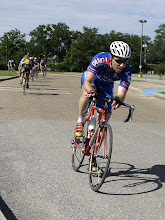Myopia
Myopia is a land very close to us in the cycling world. Myopians are around us. Their views are promoted in research, in magazines and on the web. Most of the time, I think Myopians are purely innocent individuals that are trying to help their fellow cyclists. Other times, I think they really believe that there is one aspect of cycling that reigns supreme over all other aspects. This can't be true.
The single faceted approach to cycling has served to create confusion for the general cycling community. "Well 'so in so' did 'this' or 'that' and now they are riding 15 mph faster than they were a year ago"! The single faceted approach promoted by Myopians it typically all about marketing.
I had the opportunity to have a short exchange with a Myopian recently. I rec'd and email with a statement about cycling. Based on the email, I knew where this was going. So, I replied with an apparently "ignorant" or "base" question. However, it was meant to be bait. The question was asked to flush out the single faceted approach that was being promoted.
Aristotelian logic promotes that we have different types of answers to arguments, "either/or" or "both/and". In "either/or" questions, there is right and wrong. For example, if we ask, "are you pregnant?". The answer cannot be "yes" and "no". It's one or the other, it's yes or no. On the other hand, we have other types of arguments that can be answer with multiple answers that are correct. "Does a plane fly because of it's speed or the shape of the wings?". The answer here is "both". Without either one, the plane does not fly. However, don't let "both/and" argument deceive you. The answers cannot include "right" and "wrong" answers within one "both/and" argument. All answers have to be either "right" or "wrong".
Here the question I asked about his philosophy. "Does [your product or philosophy] have priority over everything else [in cycling]?" He wrote back, "Absolutely". This is the essence of the single faceted approach. He is approaching the cycling activity as something that only requires one answer and everything else is wrong. In this case, he is approaching the situation as an argument with a "either/or" solution when we need a "both/and" solution. This is ludicrous thinking at best. In my last entry, I tried to talk about the complexity of cycling. Single faceted solutions are a product of the box we have placed ourselves in. We have not studied human physiology, biomechanics and physics!
I'm in a bit of a conundrum at this point. Part of me wants to engage and share knowledge, the other part is wise enough to know that all hills are not worth dying on.
There are a couple things that come to mind. "if is sounds to good to be true, it probably is" and "complex biomechanical models require multifaceted solutions". If a Myopian approaches you with a solution to all your problems, be cautious.

